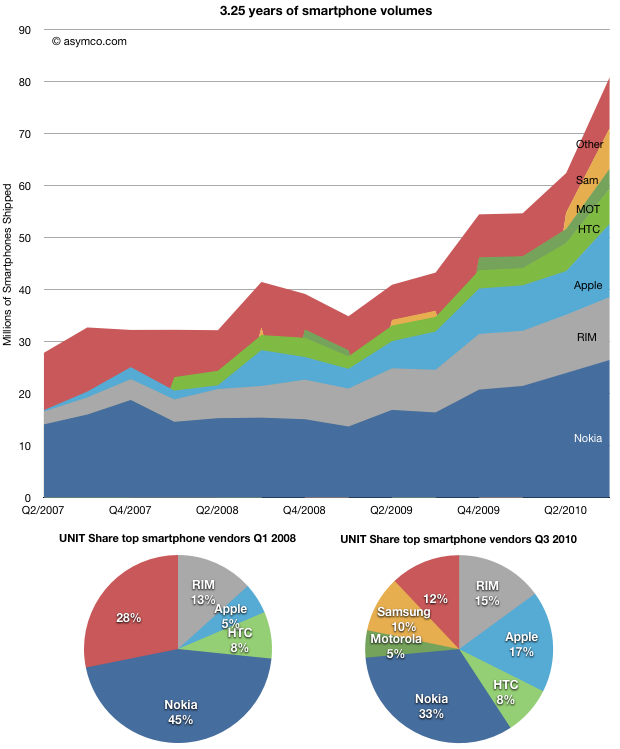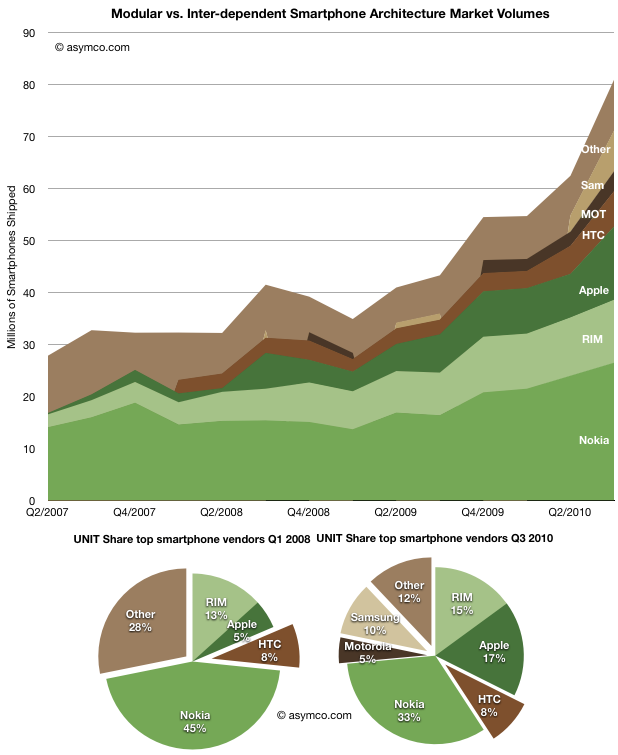If we look at the growth of smartphones independently from all phones, the category looks impressive:
Smartphones are now almost 24% of all phones, up from 10% three years ago.
What’s also impressive is all participants in the market grew their volumes. The rising tide did lift all the boats.
For this reason it’s somewhat perplexing to hear absolute statements about the imminent death of certain smartphone competitors. The non-smartphone market is still 76% of the total phone market. And it’s the biggest and easiest target for all smartphone competitors. The data shows that, for the time being, calling the end for vendors or platforms in a market that’s doubling every three years is premature.
But what I really want direct attention to here is a subset of the market: modular platforms.
If you recall from the modular vs. inter-dependent dichotomy discussion, modular architectures are a way to implement products by licensing core components rather than keeping an integrated development model. I stated that modularity tends to be the better approach when markets are mature/over-serving and inter-dependency is the better approach when markets are young and the products not-good-enough.
Looking at the chart above you should note that the market is growing extremely quickly so it’s not “mature” in that sense, implying a healthy future for inter-dependent players.
So how are modular vendors faring at this stage of the market and what are the prospects of module suppliers (i.e. mobile operating systems).
To help clarify, rather than looking at vendors individually I grouped them by architecture. I took the charts above and changed the colors so that modular vendors (in shades of brown) are represented separately from inter-dependent vendors (in shades of green).
When looking at the market this way we can make some important observations:
- Even though the overall market grew, the share of the market held by modular architectures is smaller than that for inter-dependent. It’s also not increasing. In 2008 modular players held 36%, in late 2010, they held 35%.
- The suppliers to the modular market changed over the same period, so to a large extent they are fungible. During 2007, the vast bulk of the brown area above was using Windows Mobile. The vast bulk in 2010 is using Android.
- The addressable market for Android is constrained to the modular market. Therefore the growth potential depends on whether that brown area increases dramatically relative to the green.
- Vendors don’t change architecture easily. My knowledge of the competitors makes me believe that none of the green players will change from Inter-dependent to modular, and even if they wanted to change it’s not a simple thing to do. Conversely, changing from modular to inter-dependent is enormously challenging. Company processes, competencies and priorities must change dramatically.
So what’s the bottom line?
For an Android dominant future, several conditions must be met; one will need to believe all of these to be true:
- The addressable market for modular solutions will have to grow much faster than that of inter-dependent vendors. [The chart shows in-line growth–again due to the overall growth of the market. The green guys above won’t just roll over.]
- The split of licenses between Android and Windows Phone within the addressable market must favor Android. [Again, this is unlikely as “politics” will interfere. (I won’t even touch IP issues.)]
- The current modular vendors will not become inter-dependent or the current inter-dependent vendors will become modular. [Now why would they tear themselves apart if they are growing?]
- The profitability of Android vendors must be high enough to make modularity sustainable [more about this later.]
Talk of Android (or iOS) “domination” is still wishful thinking. With the acceptance of Windows Phone within the value chain (device vendors, operators, developers), the brown area above will be served by two very powerful and motivated competitors. Politics and lawsuits will add drag on growth. Established brands are important to consumers and new brands (like ZTE and Huawei) will have a hard time joining the top tiers with or without Android. Established integrated vendors like Nokia, RIM and Apple don’t have modular DNA but do have massive distribution.
In the end, the real limitation is that the brown area itself is not going to get disproportionately large. Android is limited by its addressable market and that market is a lot smaller than the whole market.
Looking at the world through modular/inter-dependent lenses lets you see that mobile platform dynamics will not evolve as they did in the PC era. At least not for the foreseeable future.
Discover more from Asymco
Subscribe to get the latest posts sent to your email.


